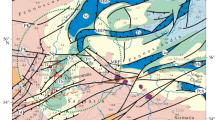Abstract
The course of the active North Anatolian Fault system from Lake Abant to Lake Sapanca was traced by its high micro-earthquake activity. If approaching from the east this section includes a broad south to north overstep (fault offset) of the main fault.
Local seismicity has been recorded in this area by a semi-permanent network of 8 stations since 1985 within the frame of the Turkish–German Joint Project for Earthquake Research. The effect of the overstep and its complex fracture kinematics are reflected by the seismicity distribution, the variations of composite fault-plane solutions, and by the spatial coda-Q distribution. Areas of different stress orientation can be distinguished and assigned to different groups of faults.
The stresses and the tectonic pattern only in part correspond to a simple model of an extensional overstep and its correlative pull-apart basin. Other types of deformation involved are characterized by normal faulting on faults parallel to the general course of the main strike-slip fault and by synthetic strike-slip faults oriented similar to Riedel shears. Shear deformation by this fault group widely distributed in an area north and east of the main fault line may play an important role in the evolution of the overstep. The development of a pull-apart basin is inhibited along the eastern half of the overstep and compatibility of both strands of the main fault (Bolu–Lake Abant and Lake Sapanca– Izmit–Marmara Sea) seems to be achieved with the aid of the fault systems mentioned. The extension of the missing part of the pull-apart basin seems to be displaced to positions remote from the Lake Abant–Lake Sapanca main fault line, i.e. to the Akyaz℩–Düzce basin tract.
Highest Q-values (lowest attenuation of seismic waves) were found in the zone of highest seismicity north and west of the overstep which is the zone of strongest horizontal tension. If high coda-Q is an indicator for strong scattering of seismic waves it might be related to extensional opening of fractures.
Similar content being viewed by others
Author information
Authors and Affiliations
Additional information
Received: 1 April 1995 / Accepted 6 September 1996
Rights and permissions
About this article
Cite this article
Neugebauer, J., Löffler, M., Berckhemer, H. et al. Seismic observations at an overstep of the western North Anatolian Fault (Abant–Sapanca region, Turkey). Geol Rundsch 86, 93–102 (1997). https://doi.org/10.1007/s005310050124
Issue Date:
DOI: https://doi.org/10.1007/s005310050124




